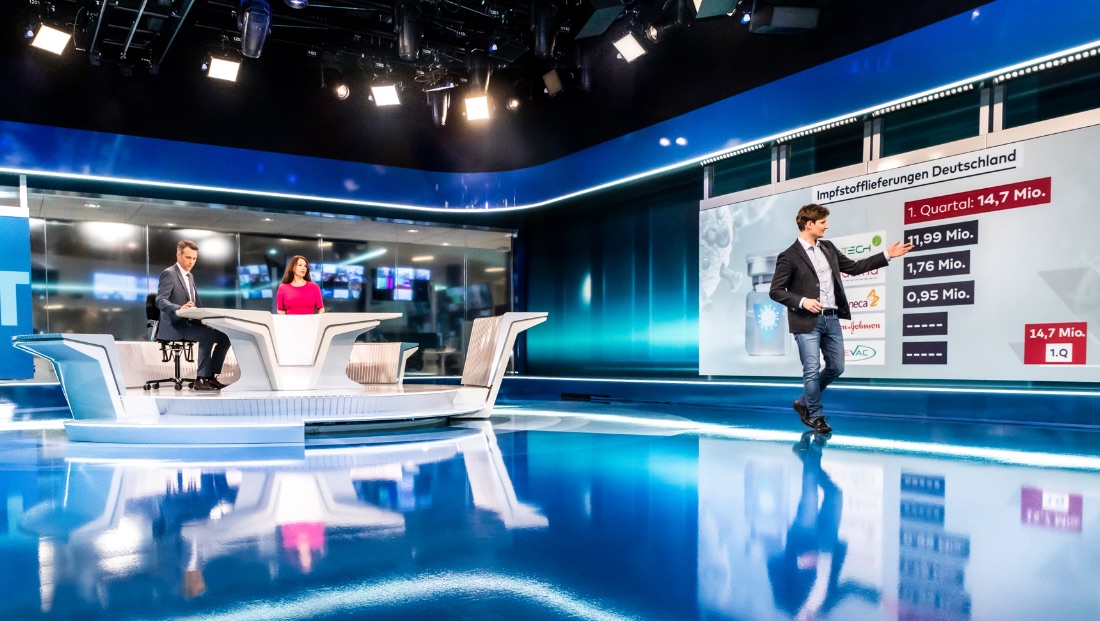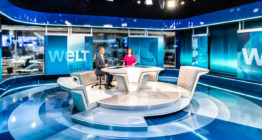WELT automates production, workflows in new facility with Vizrt tools

The new broadcast studio for WELT in Germany has been build from the ground up with IP production in mind, utilizing SMPTE 2110 workflows for multiple pieces of its operation.
“Creating a news broadcast facility is a technical challenge even with traditional architecture. What we invented at WELT are innovative workflows for every step needed to create the program we envisioned. This influenced the choice of journalist and automation tools and how our infrastructure needs to work and can be controlled. Our intention was not to eliminate the switcher. With the flexibility and functionality from software components and the underlying IP infrastructure, there was no need for one anymore,” said Thorsten Prohm, CTO for WELT.
Working through systems integrator Qvest Media, Vizrt delivered a number of software tools to streamline workflows including Viz Mosart for automation, Viz One for asset management, Viz Pilot Edge for journalist workflows, Viz Multiplay for video wall content control, and Viz Engine to power, interconnect, and output.
“The creative minds behind the workflows and aesthetics of WELT approached Vizrt with a concept where they wanted to take full control over every aspect of the production chain. Together we designed a setup which is entirely software-based and functions without a production switcher. A technical challenge like this not only requires the modules to work, but a deep collaboration between the parties,” said Gerhard Lang, CTO for Vizrt.
Flexibility through software
To work without a traditional hardware production switcher, the planners at WELT had to think software-first to solve their challenges.
All mix/effects (M/E’s) and digital video effects (DVEs), as well as all content for the moving LED videowalls and the state-of-the-art virtual studio are done with software.
WELT’s journalists also benefit from the flexibility that a modern software-defined solution can deliver, as they utilize the latest in template-driven software storytelling tools connected with their NRCS, enabling them to work from any location right up to the final second before air time to file their stories and deliver content.
An automation challenge
The WELT vision included having highly automated workflows that eliminate on-air errors. The advanced studio setup features robotic cameras on Shotoku Broadcast Systems pedestals along with fully motorized LED panels and IP-controlled lighting, making it a highly complex challenge.
To achieve their vision, the broadcaster relies on Viz Mosart to orchestrate the interplay between many different and (literally) moving elements with accuracy and reliability. Content on the advanced video walls are also driven by software, being controlled by a combination of Viz Multiplay and Viz Mosart.
Streamlined and resource-conscious IP workflows
A guiding principle of the project was to maximize performance while keeping a close control on resource usage to optimize operational efficiency.
The setup takes full advantage of a SMPTE 2110 NMOS infrastructure with the help of an orchestrator and a broadcast controller. Pooling of inputs for fast access and for assignment through NMOS plays a vital role in keeping the setup lean and nimble, and ensures that while performance is always at peak, only the needed bandwidth is used all the way through the interconnected IP infrastructure.
The fully SMPTE 2110-compatible Viz Engines deployed in the installation carry out clip playback in addition to graphics work.
Subscribe to NCS for the latest news, project case studies and product announcements in broadcast technology, creative design and engineering delivered to your inbox.





Categories
AV Integration & Broadcast Systems Integration, Broadcast Automation, Broadcast Engineering, Broadcast Facility, Broadcast Facility Technology, Featured, Industry Feed, IP Based Production
The content on this page is provided by the featured companies. NewscastStudio cannot guarantee the accuracy or veracity of any claims about products or services made in this content. The views expressed in this content do not necessarily reflect the views of NewscastStudio or its team. This content may contain trademarks owned by third parties, and those marks are the property of those companies.